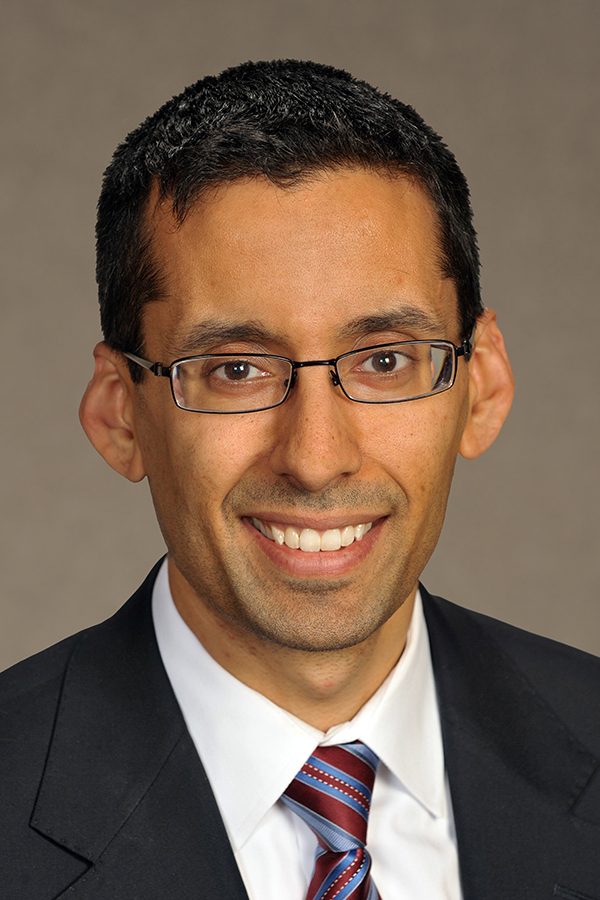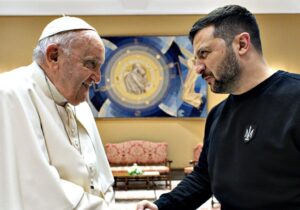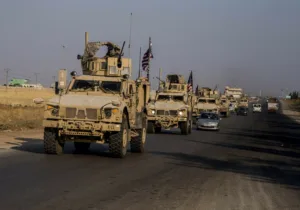The long, almost infinitely complex history of debates over nuclear weapons and arms control over the past 75 years can nevertheless be distilled into two camps. In the first are those who argue the priority must be on efforts focused on limiting (or even eliminating) nuclear arms, believing this will lead to hostile nations improving their behavior. In the second group are those who argue the priority must be on efforts focused on improving the behavior of hostile regimes, believing this will lead to better arms control agreements. Edward Ifft, writing recently at Christianity Today, stands firmly in the former camp. We are in the latter.
We admit this is an oversimplification. The process itself of arms control negotiations can sometimes contribute to adversarial regimes lessening their hostility, and the proliferation of nuclear weapons into the wrong hands can undermine world order and peace. Yet as Christians consider the hard questions of nuclear weapons and arms control, we think it helpful to surface these core issues.
Put another way, what matters more: the nature of a nation’s government, or the weapons it possesses? Should we worry more about the nuclear arsenals of democracies such as the United Kingdom and France than the nuclear arsenals of China and North Korea? Or the nuclear ambitions of Iran, for that matter? The question answers itself. The United States faces the twin threats of authoritarian aggression from a resurgent Russia and a rising China, yet Ifft downplays Russia and does not even once mention China. The omission is telling.
Ifft makes two appeals to Christians: at the abstract level that we reflect more carefully on nuclear weapons, and at the policy level that we support the New START treaty as a step toward full nuclear disarmament. He makes a cursory nod to past evangelical Protestant thinking on the issue while endorsing Pope Francis’ recent call for nuclear abolitionism. (Curiously, Ifft sequesters Augustine in the Catholic tradition, when Protestant political theology embraces the Bishop of Hippo as our spiritual ancestor as well. In fact Protestant just war theorists such as Paul Ramsey, Jean Bethke Elshtain, and James Turner Johnson are all Augustinians).
There is in fact a richer evangelical heritage of reflection on the nuclear challenge than Ifft recognizes, beginning with the pages of Christianity Today itself. Inaugural editor Carl F.H. Henry penned an essay in 1957 on “Christ and the Atom Bomb” that drew a similar distinction as we drew at the outset. Responding to a joint call by the World Council of Churches and National Council of Churches (lodestars of liberal Protestantism) to abolish nuclear weapons, Henry pointed out that doing so disregarded the threat posed by the Soviet Union. He contended that nuclear weapons played an essential role in the American government’s responsibility to deter aggression, especially from the nuclear-armed Kremlin. Yet Henry also urged that America’s nuclear arsenal be governed by a Christian ethic of neighbor love under the “lordship of Christ.”
This meant grounding nuclear doctrine in the just war tradition with its principles of protecting civilian populations and proportionate use of force, and focus on preserving peace and promoting justice as the ends of statecraft. These were hard tasks, to be sure, especially considering the terrifying destructive power of nuclear weapons and America’s occasional failures to honor just war principles. But they were necessary considering the greater evil posed by Soviet communism, and the need to maintain a nuclear deterrent against Soviet aggression.
The most consequential Protestant thinking on just war and nuclear weapons during the Cold War came not from Reinhold Niebuhr and Paul Tillich, whom Ifft references in passing, but from a name that Ifft does not mention: the Christian ethicist Paul Ramsey. During Ramsey’s 40 years at Princeton, which overlapped almost exactly with the Cold War’s four decades, he single-handedly recovered the just war tradition and updated it for the nuclear age. Ramsey built on Henry’s insight that Christian approaches to war must be grounded in the biblical command of love of neighbor. To oversimplify Ramsey’s subtle and complex thought, in the standoff with the Soviet Union, this meant that neighbor love compelled the United States to maintain a nuclear deterrent sufficient to protect its citizens and allies from Soviet attack, and that the American arsenal should employ “counterforce” targeting rather than “countervalue.” In layman’s terms, this meant that as much as possible the US nuclear triad should be aimed at Soviet military targets rather than civilian populations, since love of neighbor also compels honoring non-combatants. As James Turner Johnson wrote in these pages last year, “Ramsey’s working from the moral ideal of love of neighbor to his concept of just war sought to fill the empty middle ground between pacifist rejection of all war, indeed any use of military force, and the limits of Niebuhr’s Christian realism, which opened the door to all-out methods of war.”
For a contrary perspective, perhaps the most notable Catholic statement on nuclear weapons during the Cold War came in 1983 with the United States Conference of Catholic Bishops’ (USCCB) pastoral letter “The Challenge of Peace” (which Ifft fails to cite, a curious omission since it aligns with his stance). The USCCB epistle condemned the arms race, marginalized nuclear deterrence, and urged major reductions in nuclear arsenals, yet its 64 densely argued pages said almost nothing about the Soviet threat.
Ethics and history both help to illuminate which approach is correct, and which is mistaken. In Nuclear Ethics, a thoughtful monograph penned back at the height of the renewed Cold War tensions of the Reagan era, Joseph Nye expanded and adapted Ramsey’s thought for a broader audience to argue for robust ethical analysis rather than the simplistic approaches usually on offer in media commentary. Nye insisted that international relations, and nuclear affairs in particular, were suitable domains for ethical reflection. He rejected the skeptics’ critique that all that mattered was power, or that states could not be asked to consider anything but crude material interest. To be sure, international relations were a tough business, but it was as wrong to ring-fence them from moral consideration as it would be to pretend that a simple moral calculus could waive away decades of the superpower arms race with the stroke of a pen.
Instead, Nye explained that every national security act, including nuclear policy, should be evaluated according to a three-fold template of ends (or motives), means, and consequences. Most of the nuclear moralizing in the 1970s and ’80s—and there was a great deal of it, fueled by the rise of arms control and mass protests like the nuclear freeze movement—focused narrowly on the means and possible consequences, slighting the ends or the actual (thus far) consequences.
The simplistic moral syllogism that Nye argued against went as follows:
- Nuclear weapons can kill hundreds of thousands, if not millions.
- Nuclear strategy involves preparing to and threatening to kill hundreds of thousands, if not millions—in extremis, potentially ending civilization.
- It would be wrong to kill millions.
- It is unethical to threaten what it is unethical to do.
- Ergo, nuclear weapons are unethical.
This syllogism fails to wrestle with the complexities of nuclear deterrence. Deterrence means raising by some increment the possibility of a catastrophe so as to reduce by some increment the possibility of another catastrophe. The devil, or rather the ethics, lay in the details of how big an increment of increase and decrease in risk. If the increased risk of nuclear war was modest and the decreased risk of other bad outcomes—conventional war, Soviet hegemony, etc.—was significant, then a robust ethical calculus might indeed allow nuclear strategy.
Moreover, if well-intentioned efforts at reducing some risks of nuclear catastrophe had the actual effect of increasing the risks of another type of nuclear catastrophe, then we would be better off without those measures. For instance, during the Cold War nuclear arms control that brought the size of the arsenals down to very low levels might sound ethically appealing—see, we have fewer megatonnage available to be used, reducing hypothetical scenarios of casualties by millions of lives. But if those reductions reached the point where the Soviets might believe they had a credible first-strike option, then the loss in deterrent power would mean such a greater risk of actual war that a robust ethical calculus would rule this disastrous.
To be sure, the field of nuclear ethics faced some irreducible uncertainties. Once the nuclear threshold was crossed, would militaries keep escalating until the arsenals were exhausted? Or could a failure of pre-war deterrence be quickly remedied by the restoration of intra-war deterrence? What would happen as more and more countries crossed the nuclear threshold? Would the risks increase exponentially, along with the potential nuclear dyads? If every nuclear weapon poses some inherent risk of accidental use, does the risk of nuclear accidents increase arithmetically along with the growth in the arsenal?
Theorists argued about all of this endlessly, and continue to argue to this day, fortunately without much evidence from the real world because, after Nagasaki, no nuclear weapon was ever used in combat.
And here is the rub. The debates over nuclear ethics were particularly lively during the Reagan era when the end of détente and the apparent exhaustion of arms control efforts intensified fears about the Cold War becoming a hot war. Perhaps, many feared, the hypothetical consequences of a nuclear exchange would be realized in the actual.
We now know what was only a theoretical possibility—that nuclear deterrence would hold—became our actual reality. The nuclear arms race, particularly the revived arms race of greatest concern to the people marching in the streets and the Catholic Bishops trying to rewrite just war theory in the nuclear age, ended not with a bang but with the collapse of the Soviet empire and the rapid reduction in the size of nuclear arsenals. This means that from the point of view of robust ethical analysis, we have a much better understanding of the actual consequences of the nuclear arms race, and those consequences were far less odious than anti-nuclear activists predicted. In fact, some argued that nuclear weapons, far from leading to nuclear war, actually led to nuclear peace.
We also know some things that were only posited about nuclear arms control four decades ago. We know that arms control probably helped moderate some of the more dangerous aspects of the superpower rivalry. The Naval Incidents at Sea Treaty and other confidence-building measures were useful contributions. Through arms control, both sides developed the diplomatic understanding and experience with each other that they needed, in the late 1980s, to bring the Cold War chapter to a peaceful conclusion.
Likewise, we learned that President Ronald Reagan’s approach of negotiating from strength rather than weakness did work. Reagan worked to reduce nuclear arsenals while saying—and doing—a great deal to confront the Soviet threat. This approach of focusing first on the adversary led to the peaceful end of the Cold War, the dissolution of the Soviet Union, and a massive reduction in nuclear weaponry in the US and Russia. While the Soviets cheated where they could, they were far more willing to make real reductions in their arsenal when they saw the correlation of historical forces turn against them than they were when they believed we were in decline. As Catholic philosopher George Weigel later wrote on the failures of the “Challenge of Peace,” nuclear reductions only came about “because of changed behavior on the part of the Soviet Union. Nuclear weapons, in other words, and contrary to the logic of the freeze movement and the anti-nuclear activism of the early 1980s, were not the disease, but one drastically inflamed symptom of the disease.”
In sum, we learned that arms control can be a valuable tool, but it needs to be harnessed to a strategy that reads history—and the nature of the threat—with clear eyes.
The Cold War is long over, thankfully—and thanks in part to America’s nuclear deterrent. But three decades after the Cold War’s end, do we still need a nuclear arsenal today? Ifft thinks not and urges his fellow Christians to believe likewise; we disagree.
The simplistic equations—nuclear weapons = bad, nuclear arms control = good—that were not, in hindsight, true at the height of the Cold War should continue to be viewed with suspicion today.
Indeed, the same basic formula that worked so well during the Cold War—a credible nuclear deterrent paired with a commitment to nonproliferation and arms control—remains vital today to addressing the greatest threats to national security the free world faces. These threats include, most prominently, both nuclear-armed powers, such as China and Russia, that are determined to reshape the international order to the benefit of autocracies and disadvantage of democracies, as well as rogue regimes, such as those in Iran and North Korea, that sow instability in their neighborhoods.
If the importance of deterrence has not ebbed, however, the nuclear landscape itself has remained dynamic, changing in complex ways. Three threats in particular present themselves today. First, new nuclear powers have emerged, most notably North Korea, and others like Iran are moving closer to the threshold of nuclear weapons despite their professed commitment to international arms control accords such as the Nonproliferation Treaty (NPT). The urge of these actors to develop or acquire nuclear weapons stems not from American possession of them, but of these regimes’ own insecurity and from the security dynamics within their regions. Their acquisition of nuclear arms, however, sharply increases the risk that others will follow in their footsteps—their allies, due to the sharing of nuclear technology, and their rivals, due to concerns over nuclear blackmail or even attack.
What has long held back the rivals of these rogue regimes—whether South Korea, Taiwan, and Japan in East Asia, or Saudi Arabia and Turkey in the Middle East—is not simply their commitment to nonproliferation, but the assurance provided by the US nuclear umbrella. As that assurance deteriorates, the risk of proliferation increases, as rumblings from Saudi Arabia, for example, already illustrate. Importantly, this assurance is tied not just to the US possession of nuclear weapons, but to our perceived reliability as an ally. As that reputation wanes—and if our commitment to possessing a nuclear deterrent wavers—we may increasingly face a world where our nuclear proliferation concerns focus not just on adversaries but on partners, repositioning themselves as the strategic landscape shifts beneath their feet.
Second, American adversaries are developing and deploying new types of nuclear weapons. China and Russia alike are fielding intermediate-range nuclear weapons, which Washington long abjured pursuant to the Intermediate-Range Nuclear Forces (INF) Treaty, a cornerstone of Cold War arms control. Yet Moscow’s increasingly flagrant disregard for the treaty and the reality of needing to compete with Beijing as it expanded its security envelope outward in Asia eventually rendered Washington’s unilateral adherence to the treaty untenable. At the other end of the nuclear spectrum, Russia has touted its pursuit of new forms of strategic nuclear weapons, such as hypersonics. While some of these projects are dubious, and some more concerning, they illustrate the determination with which Moscow is seeking to enhance its nuclear arsenal.
Third, what had long been a binary nuclear competition between superpowers has witnessed the arrival of a third party—China—whose arsenal remains small compared to those of the US and Russia but is growing in parallel with Beijing’s geopolitical ambitions. This development, perhaps more than any other, has led American policymakers to question the Cold War model of arms control and accords based upon it, such as New START. The American hesitation to renew New START boils down to two factors. First, it spares Russia the need to engage in a costly competition with the United States and possibly China in the realm of strategic nuclear weapons while doing nothing to address Moscow’s violations of arms control treaties, such as INF, the Open Skies Treaty, and the Chemical Weapons Convention. This amounts to allowing Russia to have its cake and eat it too. Second, it would place caps on the American and Russian arsenals while imposing none on Beijing, despite the fact that Chinese planners would benefit from the insights into the US and Russian arsenals provided by New START’s transparency provisions.
None of this is to say that New START should be abandoned in this round—we disagree among ourselves over whether its benefits outweigh its costs in the present strategic moment of the US-Russia rivalry and growing threat from China. But we agree that the New START model—itself a legacy of a bygone era—is unlikely to survive another five years hence.
What will be needed to mitigate these threats—the emergence of new nuclear powers, of new forms of nuclear weapons, and of a more multifaceted great power competition—is fourfold. First and foremost, it will require a renewed commitment to American leadership of the free world, and a recommitment to the alliances that form the scaffolding of the international order. Without American leadership, we will in coming years and decades face not a world led by some other power, whether China or Russia, but a more disordered and chaotic world, with all the consequences such anarchy has for stability and security. Second, it will require a determined effort to prevent the emergence of new nuclear-armed powers, and to deter existing nuclear-armed powers from proliferating nuclear technology. Third, it will take tough-minded but sincere diplomacy with both our nuclear rivals, Russia and China, and our allies aimed at limiting nuclear competition and bolstering transparency and mutual confidence. Fourth, it will require a credible American nuclear deterrent to ensure that no adversary can hold us as nuclear hostages, even if the first three lines of effort fail.
Let us be clear. We understand the desires of the nuclear abolitionists and recognize that some—like the Cold War warriors George Schultz, Henry Kissinger, Sam Nunn, and William Perry—have impeccable credentials as hard-headed pragmatists who have wrestled with these thorny issues in the real world for decades. They offer a useful voice pointing to a long-term goal and challenging unwarranted nuclear complacency.
But it the end, we fear that for the near to midterm abolitionist visions offer a tempting yet ultimately false alternative to the prudent measures that offer the best chance of minimizing the risks of nuclear war. Indeed, initiatives such as the Nuclear Ban Treaty, however well-intentioned, are not simply unproductive but may even be counter-productive. Acceding to them would mean abandoning the rigors of verification and compliance that have attended both multilateral treaties such as the NPT, as well as bilateral arms control accords, putting at risk rather than enhancing confidence and transparency. Perhaps more importantly, such initiatives risk calling into question our commitment to nuclear deterrence, which would increase instability and risk, raising rather than reducing the chance of catastrophic miscalculation.
Before embracing calls for the abolition of nuclear weapons, thoughtful Christians must confront two uncomfortable facts. First, we live in a fallen world in which the threats we face are changing, and arguably growing. Second, the envelope of peace and security in which free societies have thrived for the past eight decades is not self-sustaining—one need only view the recent decline of democracies and rise of authoritarian threats from Russia and China. One can detest nuclear weapons and still see their strategic value. Such was Reagan, who envisioned a world free of nuclear arms—but only after the world was first free of Soviet communism.
Just as defeating the Soviet Union required a limited but credible nuclear deterrent—as one part of a myriad of policies aimed at countering adversaries and strengthening friends—so too will that deterrent be vital in limiting the new great-power competition upon which we are embarking today, and ensuring that the free world remains so for the foreseeable future. Loving our neighbors under the Lordship of Christ begins with acknowledging these realities.
Peter Feaver is a professor of political science and director of the American Grand Strategy Program at Duke University. William Inboden is executive director of the Clements Center for National Security and associate professor of public policy at the LBJ School, both at the University of Texas at Austin. Michael Singh is Lane-Swig Senior Fellow and Managing Director of the Washington Institute for Near East Policy. All three authors served on the National Security Council staff during the George W. Bush administration.








